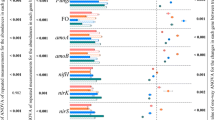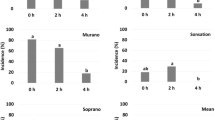Abstract
The efficacy of three steam application techniques (steam injection, iron pan and sheet steaming) was evaluated against five soilborne pathogens under controlled laboratory conditions. Injection and pan steam systems proved to be efficient and feasible alternatives to traditional sheet steaming for suppressing Fusarium oxysporum f. sp. basilici at 60% moisture field capacity in sandy-loam soil. Injecting steam was the best technique to suppress F. oxysporum f. sp. basilici, F. oxysporum f. sp. raphani, F. oxysporum f. sp. conglutinans, Rhizoctonia solani and Phytophthora capsici. The mycelia of R. solani and P. capsici were very sensitive to heat and were effectively killed by injection of steam and by the pan steam system at 80% and 40% moisture field capacity.





Similar content being viewed by others
References
Abu-Hamdeh, N. H. (2001). Measurement of the thermal conductivity of sandy loam and clay loam soils using single and dual probes. Journal of Agricultural Engineering Research, 80, 209–216.
Ajwa, H. A., Klose, S., Nelson, S. D., Minuto, A., Gullino, M. L., Lamberti, F., et al. (2003). Alternatives to methyl bromide in strawberry production in the United States of America and the Mediterranean region. Phytopathologia Mediterranea, 42, 220–244.
Baker, K. F. (1962). Principles of heat treatment of soil and planting material. Journal of the Australian Institute of Agricultural Science, 28, 118–126.
Bollen, G. J. (1969). The selective effect of heat treatment on the microflora of a greenhouse soil. Netherlands Journal of Plant Pathology, 75, 157–163.
Bollen, G. J. (1985). Lethal temperatures of soil fungi. In C. A. Parker, A. D. Rovira, K. J. Moore, & P. T. W. Wong (Eds.), Ecology and management of soilborne plant pathogens, Proceedings of the Fourth International Congress of Plant Pathology (pp. 191–193). St. Paul, MN, USA: The American Phytopathological Society.
Browning, M., Englander, L., Tooley, P. W., & Berner, D. (2008). Survival of Phytophthora ramorum hyphae after exposure to temperature extremes and various humidities. Mycologia, 100, 236–245.
Dabbene, F., Gay, P., & Tortia, C. (2003). Modeling and control of steam soil disinfestation processes. Biosystems Engineering, 84, 247–256.
Ellis, E. G. (1991). Working for growers: A review of sterilization of glasshouse soils. Contract review on behalf of Horticulture Development Council. Contract no. PC/34. Special Publication of Horticultural Development Council, Kent, UK.
Gamliel, A., & Katan, J. (1991). Involvement of fluorescent pseudomonads and other microorganisms in increased growth response of plants in solarized soils. Phytopathology, 81, 494–502.
Gay, P., Piccarolo, P., Aimonino, D. R., & Tortia, C. (2008). Soil parameters effects on steam disinfestation efficiency. AGENG 2008 Conference: Agricultural and Biosystems Engineering for a Sustainable World (Crete, Greece).
Gayed, S. K., Barr, D. J. S., & Weresub, L. K. (1978). Damping-off in tobacco seedbeds caused by Rhizoctonia solani and Pythium ultimum. Canadian Plant Disease Survey, 58, 15–19.
Gullino, M. L., Clini, C., & Garibaldi, A. (2005). Life without methyl bromide: the Italian experience in replacing the fumigant. Communications in Agricultural and Applied Biological Sciences, 70, 13–25.
Katan, J. (2000). Physical and cultural methods for the management of soil-borne pathogens. Crop Protection, 19, 725–731.
Komada, H. (1975). Development of a selective medium for quantitative isolation of Fusarium oxysporum from natural soil. Review of Plant Protection Research, 8, 114–125.
Linderman, R. G., & Davis, E. A. (2008). Eradication of Phytophthora ramorum and other pathogens from potting medium or soil by treatment with aerated steam or fumigation with metham sodium. HortTechnology, 18, 106–110.
Locke, T., & Colhoun, J. (1974). Contribution to a method of testing oil palm seedlings for resistance to Fusarium oxysporum f.sp. elaeidis Toovey. Journal of Phytopathology, 79, 77–92.
Masago, H., Yoshikawa, M., Fukada, M., & Nakanishi, N. (1977). Selective inhibition of Pythium spp. on a medium for direct isolation of Phytophthora spp. from soil and plants. Phytopathology, 67, 425–428.
Melander, B., & Jørgersen, M. H. (2005). Soil steaming to reduce intrarow weed seedling emergence. Weed Research, 45, 202–211.
Minuto, G., Gilardi, G., Kejji, S., Gullino, M. L., & Garibaldi, A. (2005). Effect of physical nature of soil and humidity on steam disinfestation. Acta Horticulturae, 698, 257–262.
Mouchacca, J. (2007). Heat tolerant fungi and applied research: addition to the previously treated group of strictly thermotolerant species. World Journal of Microbiology and Biotechnology, 23, 1755–1770.
Nash, S. M., Christou, T., & Snyder, W. C. (1961). Existence of Fusarium solani f.sp. phaseoli as chlamydospores in soil. Phytopathology, 51, 308–312.
Pullman, G. S., De Vay, J. E., & Garber, R. H. (1981). Soil solarization and thermal death: a logarithmic relationship between time and temperature for four soilborne plant pathogens. Phytopathology, 71, 959–964.
Runia, W. T. (1983). A recent development in steam sterilization. Acta Horticulturae, 152, 195–200.
Runia, W. T. (2000). Steaming methods for soils and substrates. Acta Horticulturae, 532, 115–123.
Runia, W. T., & Greenberger, A. (2005). Preliminary results of physical soil disinfestation by hot air. Acta Horticulturae, 698, 251–256.
Runia, W. T., & Molendijk, L. P. G. (2010). Physical methods for soil disinfestation in intensive agriculture: old methods and new approaches. Acta Horticulturae (in press).
Schippers, B., & Van Eck, W. H. (1981). Formation and survival of chlamydospores in Fusarium. In P. E. Nelson, T. A. Tousson, & R. J. Cook (Eds.), Fusarium, diseases, biology and taxonomy (pp. 250–260). University Park, PA, USA: Pennsylvania State University Press.
Van Loenen, M. C. A., Turbett, Y., Mullins, C. E., Feilden, N. E. H., Wilson, M. J., Leifert, C., et al. (2003). Low temperature–short duration steaming of soil kills soil-borne pathogens, nematode pests and weeds. European Journal of Plant Pathology, 109, 993–1002.
Acknowledgments
This work was supported by grants from the Italian Ministry for Environment, Land and Sea, and Piedmont Region (CIPE: Tecniche e strategie innovative e eco-compatibili per la disinfestazione dei terreni agrari in orticoltura specializzata ad alto reddito) and by a INJETVAP project. The fellowship of Pingxiang Lu was co-funded by the Italian Ministry for University and Research, the University of Torino and the Italian Ministry for Environment, Land and Sea. The authors thank Dr. Robert Milne for language revision.
Author information
Authors and Affiliations
Corresponding author
Rights and permissions
About this article
Cite this article
Lu, P., Ricauda Aimonino, D., Gilardi, G. et al. Efficacy of different steam distribution systems against five soilborne pathogens under controlled laboratory conditions. Phytoparasitica 38, 175–189 (2010). https://doi.org/10.1007/s12600-010-0086-8
Received:
Accepted:
Published:
Issue Date:
DOI: https://doi.org/10.1007/s12600-010-0086-8




